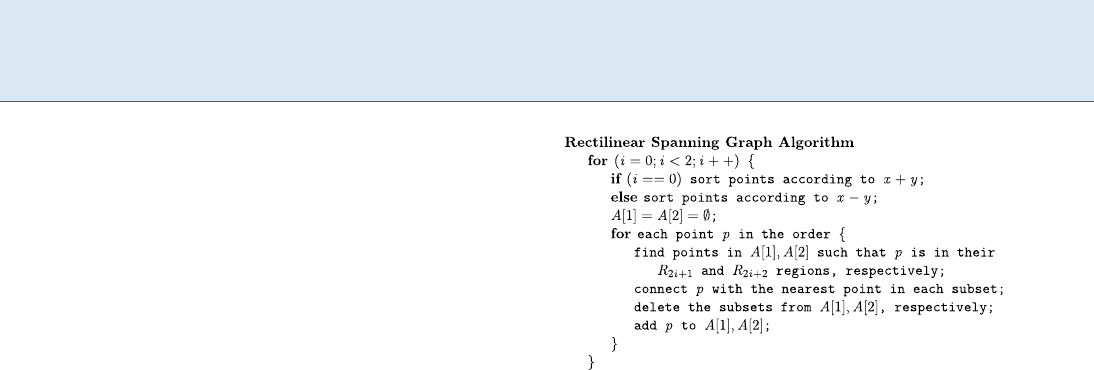Kao M.-Y. (ed.) Encyclopedia of Algorithms
Подождите немного. Документ загружается.


748 R Rank and Select Operations on Binary Strings
tions exist: a matching is rank-maximal [9] if it allocates
the maximum number of applicants to their first choice,
and then subject to this, the maximum number to their
second choice, and so on. A matching is maximum utility
if it maximizes
P
(a;p)2M
u
a;p
,whereu
a;p
is the utility of
allocating post p to applicant a. Neither rank-maximal nor
maximum-utility matchings are necessarily popular.
Cross References
Hospitals/Residents Problem
Maximum Matching
Weighted Popular Matchings
Recommended Reading
1. Abdulkadiro
ˆ
glu, A.,Sönmez, T.: Random serial dictatorship and
the core from random endowments in house allocation prob-
lems. Econom. 66(3), 689–701 (1998)
2. Abraham, D.J., Cechlárová, K., Manlove, D.F., Mehlhorn, K.:
Pareto-optimality in house al- location problems. In: Proceed-
ings of the 15th International Symposium on Algorithms and
Computation, (LNCS, vol. 3341), pp. 3–15. Springer, Sanya,
Hainan (2004)
3. Abraham, D.J., Irving, R.W., Kavitha, T., Mehlhorn, K.: Popular
matchings. In: Proceedings of the 16th ACM-SIAM Symposium
on Discrete Algorithms, pp. 424–432. SIAM, Vancouver (2005)
4. Gale, D., Shapley, L.S.: College admissions and the stability of
marriage. Am. Math. Mon. 69, 9–15 (1962)
5. Gardenfors, P.: Match Making: assignments based on bilateral
preferences. Behav. Sci. 20, 166–173 (1975)
6. Guseld, D., Irving, R.W.: The Stable Marriage Problem: Structure
and Algorithms. MIT Press, Cambridge (1989)
7. Hopcroft, J.E., Karp, R.M.: A n
5/2
AlgorithmforMaximumMatch-
ings in Bipartite Graphs. SIAM J. Comput. 2, 225–231 (1973)
8. Hylland, A., Zeckhauser, R.: The ecient allocation of individuals
to positions. J. Political Econ. 87(2), 293–314 (1979)
9. Irving, R.W., Kavitha, T., Mehlhorn, K., Michail, D., Paluch, K.:
Rank-maximal matchings. In: Proceedings of the 15th ACM-
SIAM Symposium on Discrete Algorithms, pp. 68–75. SIAM,
New Orleans (2004)
10. Roth, A.E., Postlewaite, A.: Weak versus strong domination in
a market with indivisible goods. J. Math. Econ. 4, 131–137
(1977)
11. Yuan, Y.: Residence exchange wanted: a stable residence ex-
change problem. Eur. J. Oper. Res. 90, 536–546 (1996)
12. Zhou, L.: On a conjecture by Gale about one-sided matching
problems. J. Econ. Theory 52(1), 123–135 (1990)
Rank and Select Operations
on Binary Strings
1974; Elias
NAILA RAHMAN,RAJEEV RAMAN
Department of Computer Science,
University of Leicester, Leicester, UK
Keywords and Synonyms
Binary bit-vector; Compressed bit-vector, Rank and select
dictionary; Fully indexable dictionary (FID)
Problem Definition
Given a static sequence b = b
1
:::b
m
of m bits, to pre-
process the sequence and to create a space-efficient data
structure that supports the following operations rapidly:
rank
1
(i) takes an index i as input, 1 i m, and returns
the number of 1samongb
1
:::b
i
.
select
1
(i) takes an index i 1 as input, and returns the
position of the ith 1 in b,and1ifi is greater than the
number of 1sinb.
The operations rank
0
and select
0
are defined analo-
gously for the 0sinb.Asrank
0
(i)=i rank
1
(i), one
considers just rank
1
(abbreviated to rank), and refers to
select
0
and select
1
collectively as select. In what follows,
|x| denotes the length of a bit sequence x and w(x) denotes
the number of 1sinit.b is always used to denote the input
bit sequence, m to denote |b|andn to denote w(b).
Models of Computation, Time and Space Bounds
Two models of computation are commonly considered.
One is the unit-cost RAM model with word size O(lg m)
bits [1]. The other model, which is particularly useful for
proving lower bounds, is the bit-probe model, where the
data structure is stored in bit-addressablememory, and the
complexity of answering a query is the worst-case number
of bits of the data structure that are probed by the algo-
rithm to answer that query. In the RAM model, the algo-
rithm can read O(lg m) consecutive bits in one step, so sup-
porting all operations in O(1) time on the RAM model im-
plies a solution that uses O(lg m) bit-probes, but the con-
verse is not true.
This entry considers three variants of the problem: in
each variant, rank and select must be supported in O(1)
time on the RAM model, or in O(lg m)bit-probes.How-
ever, the use of memory varies:
Problem 1 (Bit-Vector) Theoverallspaceusedmustbe
m + o(m) bits.
Problem 2 (Bit-Vector Index) b isgiveninread-only
memory and the algorithm can create auxiliary data struc-
tures (called indices) which must use o(m) bits.
Indices allow the representation of b to be de-coupled
from the auxiliary data structure, e. g., b can be stored (in
a potentially highly compressed form) in a data structure

Rank and Select Operations on Binary Strings R 749
such as that of [6,9,17] which allows access to O(lg m)con-
secutive bits of b in O(1) time on the RAM model. Most
bit-vectors developed to date are bit-vector indices.
Recalling that n = w(b), observe that if m and n are
known to an algorithm, there are only l =
m
n
possibili-
ties for b, so an information-theoretically optimal encod-
ing of b would require B(m; n)=dlg le bits (it can be ver-
ified that B(m; n) < m for all m, n). The next problem is:
Problem 3 (Compressed Bit-Vector) The overall space
used must be B(m; n)+o(n) bits.
It is helpful to understand the asymptotics of B(m; n)in
order to appreciate the difference between the bit-vector
and the compressed bit-vector problems:
Using standard approximations of the factorial func-
tion, one can show [14]that:
B(m; n)=n lg(m/n)+n lg e + O(n
2
/m)(1)
If n = o(m), then B(m; n)=o(m), and if such a sparse
sequence b were represented as a compressed bit-
vector, then it would occupy o(m) bits, rather than
m + o(m)bits.
B(m; n)=m O(lg m), whenever jm/2 nj =
O(
p
m lg m). In such cases, a compressed bit-vector
will take about the same amount of space as a bit-
vector.
Taking p = n/m; H
0
(b)=(1/p)lg(1/p)+(1/(1
p)) lg(1/(1 p)) is the empirical zeroth-order entropy
of b.Ifb is compressed using an ‘entropy’ compres-
sor such as non-adaptive arithmetic coding [18], the
size of the compressed output is at least mH
0
(b)bits.
However, B(m; n)=mH
0
(b) O(log m). Applying
Golomb coding to the ‘gaps’ between successive 1s,
which is the best way to compress bit sequences that
represent inverted lists [18], also gives a space usage
close to B(m; n)[4].
Related Problems
Viewing b as the characteristic vector of a set S U =
f1;:::;mg, note that the well-known predecessor prob-
lem – given y 2 U,returnpred(y)=maxfz 2 Sjz
yg – may be implemented as select
1
(rank
1
(y)). One may
also view b as a multiset of size m n over the universe
f1;:::;n +1g [5]. First, append a 1 to b. Then, take each of
the n+1 1s to be the elementsof the universe,and the num-
ber of consecutive 0s immediately preceding a 1 to indicate
their multiplicities. For example, b = 01100100 maps to
the multiset f1; 3; 3; 4; 4g. Seen this way, select
1
(i) i on
b gives the number of items in the multiset that are i,
and select
0
(i) i + 1 gives the value of the ith element of
the multiset.
Lower-Order Terms
From an asymptotic viewpoint, the space utilization is
dominated by the main terms in the space bound. How-
ever, the second (apparently lower-order) terms are of
interest for several reasons, primarily because the lower-
order terms are extremely significant in determining
practical space usage, and also because non-trivial space
bounds have been proven for the size of the lower-order
terms.
Key Results
Reductions
It has been already noted that rank
0
and rank
1
reduce to
each other, and that operations on multisets reduce to se-
lect operations on a bit sequence. Some other reductions,
whereby one can support operations on b by performing
operations on bit sequences derived from b are:
Theorem 1
(a) rank reduces to select
0
on a bit sequence c such that
jcj = m + nandw(c)=n.
(b) If b has no consecutive 1s, then select
0
on b can be re-
duced to rank on a bit sequence c such that jcj = m n
and w(c) is either n 1 or n.
(c) From b one can derive two bit sequences b
0
and b
1
such
that jb
0
j = m n; jb
1
j = n; w(b
0
); w(b
1
) minfm
n; ng and select
0
and select
1
on b can be supported by
supporting select
1
and rank on b
0
and b
1
.
Parts (a) and (b) follow from Elias’s observations on mul-
tiset representations (see the “Related Problems” para-
graph), specialized to sets. For part (a), create c from b by
adding a 0 after every 1. For example, if b = 01100100 then
c = 01010001000.Then,rank
1
(i)onb equals select
0
(i)
i on c. For part (b), essentially invert the mapping of
part (a). Part (c) is shown in [3].
Bit-Vector Indices
Theorem 2 ([8]) There is an index of size (1 +
o(1))(m lg lg m/lgm)+O(m/lgm) that supports rank and
select in O(1) time on the RAM model.
Elias previously gave an o(m)-bit index that supported se-
lect in O(lg m) bit-probes on average (where the average
was computed across all select queries). Jacobson gave
o(m)-bit indices that supported rank and select in O(lg m)
bit-probes in the worst case. Clark and Munro [2]gavethe
first o(m)-bitindicesthatsupportbothrank and select in
O(1) time on the RAM. A matching lower bound on the

750 R Rank and Select Operations on Binary Strings
size of indices has also been shown (this also applies to in-
dices which support rank and select in O(1) time on the
RAM model):
Theorem 3 ([8]) Any index that allows rank or
select
1
to be supported in O(lg m) bit-probes has size
˝(m lg lg m/lgm) bits.
Compressed Bit-Vectors
Theorem 4 There is a compressed bit-vector that uses:
(a) B(m; n)+O(m lg lg m/lgm) bits and supports rank
and select in O(1) time.
(b) B(m; n)+O(n(lg lg n)
2
/lgn) bits and supports rank in
O(1) time, when n = m/(lg m)
O(1)
.
(c) B(m; n)+O(n lg lg n/
p
lg n) bits and supports select
1
in O(1) time.
Theorem 4(a) and (c) were shown by Raman et al. [16]
and Theorem 4(b) by Pagh [14]. Note that Theorem 4(a)
has a lower-order term that is o(m), rather than o(n)as
required by the problem statement. As compressed bit-
vectors must represent b compactly, they are not bit-vector
indices, and the lower bound of Theorem 3 does not ap-
ply to compressed bit-vectors. Coarser lower bounds are
obtained by reduction to the predecessor problem on sets
of integers, for which tight upper and lower bounds in the
RAM model are now known. In particular the work of [15]
implies:
Theorem 5 Let U = f1;:::;Mg and let S U; jSj = N.
Any data structure on a RAM with word size O(lg M) bits
that occupies at most O(N lg M) bits of space can sup-
port predecessor queries on S in O(1) time only when N =
M/(lg M)
O(1)
or N =(lgM)
O(1)
.
As noted in the paragraph “Related Problems”, the pre-
decessor problem can be solved by the use of rank and
select
1
operations. Thus, Theorem 5 has consequences for
compressed bit-vector data structures, which are spelt out
below:
Corollary 1 There is no data structure that uses B(m; n)+
o(n) bits and supports either rank or select
0
in O(1) time
unless n = m/(lg m)
O(1)
,orn=(logm)
O(1)
.
Given a set S U = f1;:::;mg; jSj = n,wehavealready
noted that the predecessor problem on S is equivalent to
rank and select
1
on a bit-vector c with w(c)=n,and
jcj = m. However, B(m; n)+o(n)=O(n lg m). Thus, given
a bit-vector that uses B(m; n)+o(n) bits and supports rank
in O(1) time for m = n(lg n)
!(1)
, we can augment it with
the trivial O(1)-time data structure for select
1
,thatstores
the value of select
1
(i)fori =1;:::;n (which occupies
afurtherO(n lg m) bits), solving the predecessor problem
in O(1) time, a contradiction. The hardness of select
0
is
shown in [16], but follows easily from Theorem 1(a) and
Eq. (1).
Applications
There are a vast number of applications of bit-vectors in
succinct and compressed data structures (see e. g. [12]).
Such data structures are used for, e. g., text indexing, com-
pact representations of graphs and trees, and representa-
tions of semi-structured (XML) data.
Experimental Results
Several teams have implemented bit-vectors and com-
pressed bit-vectors. When implementing bit-vectors for
good practical performance, both in terms of speed and
space usage, the lower-order terms are very important,
even for uncompressed bit-vectors
1
,andcandominatethe
space usage even for bit-vector sizes that are at the limit
of conceivable future practical interest. Unfortunately, this
problem may not be best addressed purely by a theoretical
analysis of the lower-order terms. Bit-vectors work by par-
titioning the input bit sequence into (usually equal-sized)
blocks at several levels of granularity – usually 2–3 levels
are needed to obtain a space bound of m +o(m)bits.How-
ever, better space usage – as well as better speed – in prac-
tice can be obtained by reducing the number of levels, re-
sulting in space bounds of the form (1 + )m bits, for any
>0, with support for rank and select in O(1/)time.
Clark [2] implemented bit-vectors for external-
memory suffix trees. More recently, an implementation
using ideas of Clark and Jacobson was used by [7], which
occupied (1+)m bits and supported operations in O(1/)
time. Using a substantially different approach, Kim et
al. [11] gave a bit-vector that takes (2 + )n bits to support
rank and select. Experiments using bit sequences derived
from real-world data in [3,4] showed that if parameters are
settoensurethat[11]and[7] use similar space – on typ-
ical inputs – the Clark–Jacobson implementation of [7]is
somewhat faster than an implementation of [11]. On some
inputs, the Clark–Jacobson implementation can use signif-
icantly more space, whereas Kim et al.’s bit-vector appears
to have stable space usage; Kim et al.’s bit-vector may also
be superior for somewhat sparse bit-vectors. Combining
ideas from [7,11], a third practical bit-vector (which is not
1
For compressed bit-vectors, the ‘lower-order’ o(m)oro(n)term
can dominate B(m; n), but this is not our concern here.

Rate-Monotonic Scheduling R 751
a bit-vector index) was described in [4], and appears to
have desirable features of both [11]and[7]. A first imple-
mentational study on compressed bit-vectors can be found
in [13] (compressed bit-vectors supporting only select
1
were considered in [4]).
URL to Code
Bit-vector implementations from [3,4,7]canbefoundat
http://hdl.handle.net/2381/318.
Cross References
Arithmetic Coding for Data Compression
Compressed Text Indexing
Succinct Encoding of Permutations: Applications to
Text Indexing
Tree Compression and Indexing
Recommended Reading
1. Aho, A.V., Hopcroft, J.E., Ullman, J.D.: The Design and Analysis
of Computer Algorithms. Addison-Wesley (1974)
2. Clark, D., Munro, J.I.: Efficient suffix trees on secondary storage.
In: Proc. 7th ACM-SIAM SODA, pp. 383–391 (1996)
3. Delpratt, O., Rahman, N., Raman, R.: Engineering the LOUDS
succinct tree representation. In: Proc. WEA 2006. LNCS,
vol. 4007, pp. 134–145. Springer, Berlin (2006)
4. Delpratt,O.,Rahman,N.,Raman,R.:Compressedprefixsums.
In: Proc. SOFSEM 2007. LNCS, vol. 4362, pp. 235–247 (2007)
5. Elias, P.: Efficient storage retrieval by content and address of
static files. J. ACM, 21(2):246–260 (1974)
6. Ferragina, P., Venturini, R.: A simple storage scheme for strings
achieving entropy bounds. Theor. Comput. Sci. 372, 115–121
(2007)
7. Geary, R.F., Rahman, N., Raman, R., Raman, V.: A simple optimal
representation for balanced parentheses. Theor. Comput. Sci.
368, 231–246 (2006)
8. Golynski, A.: Optimal lower bounds for rank and select indexes.
In: Proc. ICALP 2006, Part I. LNCS, vol. 4051, pp. 370–381 (2006)
9. González, R., Navarro, G.: Statistical encoding of succinct data
structures. In: Proc. CPM 2006. LNCS, vol. 4009, pp. 294–305.
Springer, Berlin (2006)
10. Jacobson, G.: Space-efficient static trees and graphs. In: Proc.
30th FOCS, pp. 549–554 (1989)
11. Kim, D.K., Na, J.C., Kim, J.E., Park, K.: Efficient implementation of
Rank and Select functions for succinct representation. In: Proc.
WEA 2005. LNCS, vol. 3505, pp. 315–327 (2005)
12. Munro, J.I., Srinivasa Rao, S.: Succinct representation of data
structures.In:Mehta,D.,Sahni,S.(eds.)HandbookofData
Structures with Applications, Chap 37. Chapman and Hall/CRC
Press (2005)
13. Okanohara, D., Sadakane, K.: Practical entropy-compressed
rank/select dictionary. In: Proc. 9th ACM-SIAM Workshop on Al-
gorithm Engineering and Experiments (ALENEX ’07), SIAM, to
appear (2007)
14. Pagh, R.: Low redundancy in static dictionaries with constant
query time. SIAM J. Comput. 31, 353–363 (2001)
15. Patrascu, M., Thorup, M.: Time-space trade-offs for predecessor
search. In: Proc. 38th ACM STOC, pp. 232–240 (2006)
16. Raman, R., Raman, V., Rao, S.S.: Succinct indexable dictionaries,
with applications to representing k-ary trees and multisets. In:
Proc. 13th ACM-SIAM SODA, pp. 233–242 (2002)
17. Sadakane, K., Grossi, R.: Squeezing succinctdata structures into
entropy bounds. In: Proc. 17th ACM-SIAM SODA, pp. 1230–
1239. ACM Press (2006)
18. Witten,I.,Moffat,A.,Bell,I.:ManagingGigabytes,2ndedn.Mor-
gan Kaufmann (1999)
Rate Adjustment and Allocation
Schedulers for Optimistic Rate Based Flow Control
Rate-Monotonic Scheduling
1973; Liu, Layland
NATHAN FISHER,SANJOY BARUAH
Department of Computer Science,
University of North Carolina, Chapel Hill, NC, USA
Keywords and Synonyms
Real-time systems; Static-priority scheduling; Fixed-prio-
rity scheduling; Rate-monotonic analysis
Problem Definition
Liu and Layland [9] introduced rate-monotonic schedul-
ing in the context of the scheduling of recurrent real-time
processes upon a computing platform comprised of a sin-
gle preemptive processor.
The Periodic Task Model
The periodic task abstraction models real-time processes
that make repeated requests for computation. As defined
in [9], each periodic task
i
is characterized by an ordered
pair of positive real-valued parameters (C
i
; T
i
), where C
i
is the worst-case execution requirement and T
i
the period
ofthetask.Therequestsforcomputationthataremadeby
task
i
(subsequently referred to as jobs that are generated
by
i
) satisfy the following assumptions:
A1:
i
’s first job arrives at system start time (assumed to
equal time zero), and subsequent jobs arrive every T
i
time units. I.e., one job arrives at time-instant k T
i
for all integer k 0.
A2: Each job needs to execute for at most C
i
time units.
I.e., C
i
is the maximum amount of time that a proces-
sor would require to execute each job of
i
,without
interruption.

752 R Rate-Monotonic Scheduling
A3: Each job of
i
must complete before the next job ar-
rives. Thatis, each job of task
i
must complete execu-
tion by a deadline that is T
i
time-units after its arrival
time.
A4: Each task is independent of all other tasks – the exe-
cution of any job of task
i
is not contingent on the
arrival or completion of jobs of any other task
j
.
A5: A job of
i
may be preempted on the processor with-
out additional execution cost. In other words, if a job
of
i
is currently executing, then it is permitted that
this execution be halted, and a job of a different task
j
begin execution immediately.
Aperiodictasksystem
def
= f
1
;
2
;:::;
n
g is a collec-
tion of n periodic tasks. The utilization U()isdefinedas
follows:
U()
def
=
n
X
i=1
C
i
/T
i
: (1)
Intuitively, this denotes the fraction of time that may be
spent by the processor executing jobs of tasks in ,inthe
worst case.
The Rate-Monotonic Scheduling Algorithm
A (uniprocessor) scheduling algorithm determines which
task executes on the shared processor at each time-instant.
If a scheduling algorithm is guaranteed to always meet
all deadlines when scheduling a task system ,then is
said to be schedulable withrespecttothatschedulingalgo-
rithm.
Many scheduling algorithms work as follows: At each
time-instant, they assign a priority to each job, and se-
lect for execution the greatest-priority job with remain-
ing execution. A static priority (often called fixed priority)
scheduling algorithm for scheduling periodic tasks is one
in which it is required that all the jobs of each periodic task
be assigned the same priority.
Liu and Layland [9]proposedtherate-monotonic (
RM)
static priority scheduling algorithm, which assigns priority
to jobs according to the period parameter of the task that
generates them: the smaller the period, the higher the pri-
ority.HenceifT
i
< T
j
for two tasks
i
and
j
,theneach
job of
i
has higher priority than all jobs of
j
and hence
any executing job of
j
will be preempted by the arrival of
one of
i
’s jobs. Ties may be broken arbitrarily but con-
sistently – if T
i
= T
j
, then either all jobs of
i
are assigned
higher priority than all jobs of
j
,oralljobsof
j
are as-
signed higher priority than all jobs of
i
.
Key Results
Results from the original paper by Liu and Layland [9]are
presented in Sect. “Results from [9]” below; results extend-
ing the original work are briefly described in Sect. “Results
since [9]”.
Results from [9]
Optimality Liu and Layland were concerned with de-
signing “good” static priority scheduling algorithms. They
defined a notion of optimality for such algorithms: A static
priority algorithm
Ais optimal if any periodic task system
that is schedulable with respect to some static priority al-
gorithm is also schedulable with respect to
A.
Liu and Layland obtained the following result for the
rate-monotonic scheduling algorithm (
RM):
Theorem 1 For periodic task systems,
RM is an optimal
static priority scheduling algorithm.
Schedulability Testing A schedulability test for a par-
ticular scheduling algorithm determines, for any periodic
task system ,whether is schedulable with respect to that
scheduling algorithm. A schedulability test is said to be ex-
act if it is the case that it correctly identifies all schedula-
ble task systems, and sufficient if it identifies some, but not
necessarily all, schedulable task systems.
In order to derive good schedulability tests for the rate-
monotonic scheduling algorithm, Liu and Layland consid-
ered the concept of response time. The response time of
a job is defined as the elapsed time between the arrival of
a job and its completion time in a schedule; the response
time of a task is defined to be the largest response time
that may be experienced by one its jobs. For static priority
scheduling, Liu and Layland obtained the following result
on the response time:
Theorem 2 The maximum response time for a periodic
task
i
occurs when a job of
i
arrives simultaneously
with jobs of all higher-priority tasks. Such a time-instant is
known as the critical instant for task
i
.
Observe that the critical instant of the lowest-priority task
in a periodic task system is also a critical instant for all
tasks of higher priority. An immediate consequence of the
previous theorem is that the response-time of each task
in the periodic task system can be obtained by simulat-
ing the scheduling of the periodic task system starting at
the critical instant of the lowest-priority task. If the re-
sponse time for each task
i
obtained from such simula-
tion does not exceed T
i
, then the task system will always
meet all deadlines when scheduled according to the given

Rate-Monotonic Scheduling R 753
priority assignment. This argument immediately gives rise
to a schedulability analysis test [7] for any static priority
scheduling algorithm. Since the simulation may need to
be carried out until max
n
i=1
fT
i
g, this schedulability test has
run-time pseudo-polynomial in the representation of the
task system:
Theorem 3 ([7]) Exact rate-monotonic schedulability
testing of a periodic task system may be done in time
pseudo-polynomial in the representation in the task system.
Liu and Layland also derived a polynomial-time sufficient
(albeit not exact) schedulability test for
RM,basedupon
the utilization of the task system:
Theorem 4 Let n denote the number of tasks in periodic
task system .IfU( ) n(2
1/n
1),then is schedulable
with respect to the
RM scheduling algorithm.
Results since [9]
The utilization-bound sufficient schedulability test (The-
orem 4) was shown to be tight in the sense that for all n,
there are unschedulable task systems comprised of n tasks
with utilization exceeding n(2
1/n
1) by an arbitrarily
small amount. However, tests have been devised that ex-
ploit more knowledge about tasks’ period parameters. For
instance, Kuo and Mok [6] provide a potentially superior
utilization bound for task systems in which the task period
parameters tend to be harmonically related – exact multi-
ples of one another. Suppose that a collection of numbers
is said to comprise a harmonic chain if for every two num-
bers in the set, it is the case that one is an exact multiple of
the other. Let
˜
n denote the minimum number of harmonic
chains into which the period parameters fT
i
g
n
i=1
of tasks in
may be partitioned; a sufficient condition for task system
to be RM-schedulable is that
U()
˜
n(2
1/
˜
n
1) :
Since
˜
n n for all task systems , this utilization bound
above is never inferior to the one in Theorem 4, and is su-
perior for all for which
˜
n < n.
A different polynomial-time schedulability test was
proposed by Bini, Buttazzo, and Buttazzo [3]: they showed
that
n
Y
i=1
((C
i
/T
i
)+1) 2
is sufficient to guarantee that the periodic task system
f
1
;
2
;:::;
n
g is rate-monotonic schedulable. This test is
commonly referred to as the hyperbolic schedulability test
for rate-monotonic schedulability. The hyperbolic test is
in general known to be superior to the utilization-based
test of Theorem 4 – see [3]fordetails.
Other work done since the seminal paper of Liu and
Layland has focused on relaxing the assumptions of the
periodic task model.
The (implicit-deadline) sporadic task model relaxed
assumption A1 by allowing T
i
to be the minimum (rather
than exact) separation between arrivals of successive jobs
of task
i
.ItturnsoutthattheresultsinSect.“Results from
[9]” – Theorems 1–4 – hold for systems of such tasks as
well.
A more general sporadic task model has also been
studied that relaxes assumption A3 in addition to assump-
tion A1, by allowing for the explicit specification of a dead-
line parameter for each task (which may differ from the
task’s period). The deadline monotonic scheduling algo-
rithm [8] generalizes rate-monotonic scheduling to such
task systems.
Work has also been done [2,10] in removing the inde-
pendence assumption of A4, by allowing for different tasks
to use critical sections to access non-preemptable serially
reusable resources.
Current work is focused on scheduling tasks on mul-
tiprocessor or distributed systems where one or more of
the assumptions A1–A5 have been relaxed. In addition, re-
cent work has relaxed the assumption (A2) that worst-case
execution requirement is known and instead probabilistic
execution requirement distributions are considered [4].
Applications
The periodic task model has been invaluable for model-
ing several different types of systems. For control systems,
the periodic task model is well-suited for modeling the pe-
riodic requests and computations of sensors and actua-
tors. Multimedia and network applications also typically
involve computation of periodically arriving packets and
data. Many operating systems for real-time systems pro-
vide support for periodic tasks as a standard primitive.
Many of the results described in Sect. “Key Results”
above have been integrated into powerful tools, tech-
niques, and methodologies for the design and analysis of
real-time application systems [1,5]. Although these are
centered around the deadline-monotonic rather than rate-
monotonic scheduling algorithm, the general methodol-
ogyiscommonlyreferredtoastherate-monotonic analysis
(RMA) methodology.
Open Problems
There are plenty of interesting and challenging open prob-
lems in real-time scheduling theory; however, most of

754 R Real-Time Systems
these are concerned with extensions to the basic task and
scheduling model considered in the original Liu and Lay-
land paper [9]. Perhaps the most interesting open prob-
lem with respect to the task model in [9]isregarding
the computational complexity of schedulability analysis
of static priority scheduling. While all known exact tests
(e. g., Theorem 3) run in pseudo-polynomial time and all
known polynomial-time tests are sufficient rather than ex-
act, there has been no significant result pigeonholing the
computational complexity of static priority schedulability
analysis for periodic task systems.
Cross References
List Scheduling
Load Balancing
Schedulers for Optimistic Rate Based Flow Control
Shortest Elapsed Time First Scheduling
Recommended Reading
1.Audsley,N.,Burns,A.,Wellings,A.:Deadlinemonotonic
scheduling theory and application. Control Eng. Pract. 1,
71–78 (1993)
2. Baker, T.P.: Stack-based scheduling of real-time processes.
Real-Time Systems: The Int. J. Time-Critical Comput. 3, 67–100
(1991)
3. Bini, E., Buttazzo, G., Buttazzo, G.: Rate monotonic scheduling:
The hyperbolic bound. IEEE Trans. Comput. 52, 933–942 (2003)
4. Gardener, M.K.: Probabilistic Analysis and Scheduling ofCritical
Soft Real-Time Systems. Ph. D. thesis, Department of Computer
Science, University of Illinois at Urbana-Champaign (1999)
5. Klein,M.,Ralya,T.,Pollak,B.,Obenza,R.,Harbour,M.G.:APracti-
tioner’s Handbook for Real-Time Analysis: Guide to Rate Mono-
tonic Analysis for Real-Time Systems. Kluwer Academic Pub-
lishers, Boston (1993)
6. Kuo, T.-W., Mok, A.K.: Load adjustment in adaptive real-time
systems. In: Proceedings of the IEEE Real-Time Systems Sym-
posium, pp. 160–171. San Antonio, December 1991
7. Lehoczky, J., Sha, L., Ding, Y.: The rate monotonic scheduling
algorithm: Exact characterization and average case behavior.
In: Proceedings of the Real-Time Systems Symposium – 1989,
Santa Monica, December 1989. IEEE Computer Society Press,
pp. 166–171
8. Leung, J., Whitehead, J.: On the complexity of fixed-priority
scheduling of periodic, real-time tasks. Perform. Eval. 2,
237–250 (1982)
9. Liu, C., Layland, J.: Scheduling algorithms for multiprogram-
ming in a hard real-time environment. J. ACM 20, 46–61 (1973)
10. Rajkumar, R.: Synchronization In Real-Time Systems – A Prior-
ity Inheritance Approach. Kluwer Academic Publishers, Boston
(1991)
Real-Time Systems
Rate-Monotonic Scheduling
Rectilinear Spanning Tree
2002; Zhou, Shenoy, Nicholls
HAI ZHOU
Department of Electrical Engineering and Computer
Science, Northwestern University, Evanston, IL, USA
Keywords and Synonyms
Metric minimum spanning tree; Rectilinear spanning
graph
Problem Definition
Given a set of n points in a plane, a spanning tree is a set of
edges that connects all the points and contains no cycles.
When each edge is weighted using some distance metric
of the incident points, the metric minimum spanning tree
is a tree whose sum of edge weights is minimum. If the
Euclidean distance (L
2
) is used, it is called the Euclidean
minimum spanning tree; if the rectilinear distance (L
1
)is
used, it is called the rectilinear minimum spanning tree.
Since the minimum spanning tree problem on
a weighted graph is well studied, the usual approach
for metric minimum spanning tree is to first define an
weighted graph on the set of points and then to construct
a spanning tree on it.
Much like a connection graph is defined for the maze
search [4], a spanning graph can be defined for the mini-
mum spanning tree construction.
Definition 1 Given a set of points V in a plane, an undi-
rected graph G =(V; E) is called a spanning graph if it con-
tains a minimum spanning tree of V in the plane.
Since spanning graphs with fewer edges give more efficient
minimum spanning tree construction, the cardinality of
a spanning graph is defined as its number of edges. It is
easy to see that a complete graph on a set of points con-
tains all spanning trees, thus is a spanning graph. However,
such a graph has a cardinality of O(n
2
). A rectilinear span-
ning graph of cardinality O(n) can be constructed within
O(n log n)time[6] and will be described here.
Minimum spanning tree algorithms usually use two
properties to infer the inclusion and exclusion of edges in
a minimum spanning tree. The first property is known as
the cut property. It states that an edge of smallest weight
crossing any partition of the vertex set into two parts be-
longs to a minimum spanning tree. The second prop-
erty is known as the cycle property.Itsaysthatanedge
with largest weight in any cycle in the graph can be safely
deleted. Since the two properties are stated in connection

Rectilinear Spanning Tree R 755
Rectilinear Spanning Tree, Figure 1
Octal partition and the uniqueness property
with the construction of a minimum spanning tree, they
are useful for a spanning graph.
Key Results
Using the terminology given in [3], the uniqueness prop-
erty is defined as follows.
Definition 2 Given a point s,aregionR has the unique-
ness property with respect to s if for every pair of points
p; q 2 R; jjpqjj < max(jjspjj; jjsqjj). A partition of space
into a finite set of disjoint regions is said to have the
uniqueness property with respect to s if each of its regions
has the uniqueness property with respect to s.
The notation ||sp|| is used to represent the distance be-
tween s and p under the L
1
metric. Define the octal par-
tition of the plane with respect to s as the partition in-
duced by the two rectilinear lines and the two 45 degree
lines through s,asshowninFig.2a. Here, each of the re-
gions R
1
through R
8
includes only one of its two bounding
half line as shown in Fig. 2b. It can be shown that the octal
partition has the uniqueness property.
Lemma 1 Given a point s in the plane, the octal partition
with respect to s has the uniqueness property.
Proof To show a partition has the uniqueness property,
it needs to prove that each region of the partition has the
uniqueness property. Since the regions R
1
through R
8
are
similar to each other, a proof for R
1
will be sufficient.
The points in R
1
can be characterized by the following
inequalities
x x
s
;
x y < x
s
y
s
:
Suppose there are two points p and q in R
1
.Withoutloss
of generality, it can be assumed x
p
x
q
.Ify
p
y
q
,then
jjsqjj = jjspjj+ jjpqjj > jjpqjj. Therefore it only needs to
consider the case when y
p
> y
q
.Inthiscase,
jjpqjj = jx
p
x
q
j+ jy
p
y
q
j
= x
q
x
p
+ y
p
y
q
=(x
q
y
q
)+y
p
x
p
< (x
s
y
s
)+y
p
x
s
= y
p
y
s
x
p
x
s
+ y
p
y
s
= jjspjj:
Given two points p, q in the same octal region of
point s, the uniqueness property says that jjpqjj <
max(jjspjj; jjsqjj). Consider the cycle on points s, p,andq.
Based on the cycle property, only one point with the min-
imum distance from s needs to be connected to s.Anin-
teresting property of the octal partition is that the contour
of equi-distant points from s forms a line segment in each
region. In regions R
1
, R
2
, R
5
, R
6
, these segments are cap-
turedbyanequationoftheformx + y = c;inregionsR
3
,
R
4
, R
7
, R
8
, they are described by the form x y = c.
From each point s, the closest neighbor in each oc-
tant needs to be found. It will be described how to effi-
ciently compute the neighbors in R
1
for all points. The case
for other octant is symmetric. For the R
1
octant, a sweep
line algorithm will run on all points according to non-
decreasing x + y. During the sweep, maintained will be an
active set consisting of points whose nearest neighbors in
R
1
are yet to be discovered. When a point p is processed,
all points in the active set that have p in their R
1
regions
will be found. If s is such a point in the active set, since
points are scanned in non-decreasing x + y,thenp must
be the nearest point in R
1
for s. Therefore, the edge sp will
be added and s will be deleted from the active set. After
processing those active points, the point p will be added
into the active set. Each point will be added and deleted at
most once from the active set.
A fundamental operation in the sweep line algorithm
is to find a subset of active points such that a given point
p is in their R
1
regions. Based on the observation that
point p is in the R
1
region of point s if and only if s is
in the R
5
region of p,itneedstofindthesubsetofactive
points in the R
5
region of p.SinceR
5
can be represented as
atwo-dimensionalrange(1; x
p
] (x
p
y
p
; +1)on
(x; x y), a priority search tree [1]canbeusedtomain-
tain the active point set. Since each of the insertion and
deletion operations takes O(log n) time, and the query op-
eration takes O(log n + k)timewherek is the number of
objects within the range, the total time for the sweep is

756 R Rectilinear Spanning Tree
O(n log n). Since other regions can be processed in the
similar way as in R
1
, the algorithm is running in O(n log n)
time. Priority search tree is a data structure that relies on
maintaining a balanced structure for the fast query time.
This works well for static input sets. When the input set
is dynamic, re-balancing the tree can be quite challeng-
ing. Fortunately, the active set has a structure that can be
explored for an alternate representation. Since a point is
deleted from the active set if a point in its R
1
region is
found, no point in the active set can be in the R
1
region
of another point in the set.
Lemma 2 For any two points p, q in the active set, it must
be x
p
¤ x
q
,andifx
p
< x
q
then x
p
y
p
x
q
y
q
.
Basedonthisproperty,theactivesetcanbeorderedin
increasing order of x. This implies a non-decreasing order
on x y. Given a point s, the points which have s in their
R
1
region must obey the following inequalities
x x
s
;
x y > x
s
y
s
:
To find the subset of active points which have s in their R
1
regions, it can first find the largest x such that x x
s
,then
proceed in decreasing order of x until x y x
s
y
s
.
Since the ordering is kept on only one dimension, using
any binary search tree with O(log n) insertion, deletion,
and query time will also give us an O(n log n)timealgo-
rithm. Binary search trees also need to be balanced. An
alternative is to use skip-lists [2]whichuserandomiza-
tion to avoid the problem of explicit balancing but provide
O(log n) expected behavior.
A careful study also shows that after the sweep pro-
cess for R
1
, there is no need to do the sweep for R
5
,
since all edges needed in that phase are either connected
or implied. Moreover, based on the information in R
5
,
thenumberofedgeconnectionscanbefurtherreduced.
When the sweep step processes point s,itfindsasub-
set of active points which have s in their R
1
regions.
Without lost of generality, suppose p and q are two of
them. Then p and q are in the R
5
region of s,which
means jjpqjj < max(jjspjj; jjsqjj). Therefore, it needs only
to connect s with the nearest active point.
Since R
1
and R
2
have the same sweep sequence, they
can be processed together in one pass. Similarly, R
3
and
R
4
can be processed together in another pass. Based on the
above discussion, the pseudo-code of the algorithm is pre-
sented in Fig. 2.
The correctness of the algorithm is stated in the fol-
lowing theorem.
Rectilinear Spanning Tree, Figure 2
The rectilinear spanning graph algorithm
Theorem 3 Given n points in the plane, the rectilinear
spanning graph algorithm constructs a spanning graph in
O(n log n) time, and the number of edges in the graph is
O(n).
Proof The algorithm can be considered as deleting edges
from the complete graph. As described, all deleted edges
are redundant based on the cycle property. Thus, the out-
put graph of the algorithm will contain at least one recti-
linear minimum spanning tree.
In the algorithm, each given point will be inserted and
deleted at most once from the active set for each of the four
regions R
1
through R
4
. For each insertion or deletion, the
algorithm requires O(log n) time. Thus, the total time is
upper bounded by O(n log n). The storage is needed only
for active sets, which is at most O(n).
Applications
Rectilinear minimum spanning tree problem has wide ap-
plications in VLSI CAD. It is frequently used as a met-
ric of wire length estimation during placement. It is of-
ten constructed to approximate a minimum Steiner tree
and is also a key step in many Steiner tree heuristics. It
is also used in an approximation to the traveling salesper-
son problem which can be used to generate scan chains
in testing. It is important to emphasize that for real world
applications, the input sizes are usually very large. Since
it is a problem that will be computed hundreds of thou-
sands times and many of them will have very large in-
put sizes, the rectilinear minimum spanning tree problem
needs a very efficient algorithm.
Experimental Results
The experimental results using the Rectilinear Spanning
Graph (RSG) followed by Kruskal’s algorithm for a rec-
tilinear minimum spanning tree were reported in Zhou

Rectilinear Steiner Tree R 757
Rectilinear Spanning Tree, Table 1
Experimental Results
Input Complete Bound-degree RSG
orig distinct #edge time #edge time #edge time
1000 999 498501 5.095 s 3878 0.299 s 2571 0.112 s
2000 1996 1991010 24.096 s 7825 0.996 s 5158 0.218 s
4000 3995 7978015 2 m 7.233 s 15761 3.452 s 10416 0.337 s
6000 5991 17943045 5 m 54.697 s 23704 7.515 s 15730 0.503 s
8000 7981 31844190 13 m 7.682 s 31624 13.141 s 21149 0.672 s
10000 9962 49615741 – 39510 20.135 s 26332 0.934 s
12000 11948 – – 47424 32.300 s 31586 1.052 s
14000 13914 – – 55251 46.842 s 36853 1.322 s
16000 15883 – – 63089 1 m 3.759 s 42251 1.486 s
18000 17837 – – 70876 1 m 19.812 s 47511 1.701 s
20000 19805 – – 78723 1 m 45.792 s 52732 1.907 s
et al. [5]. Two other approaches were compared. The first
approach used the complete graph on the point set as the
input to Kruskal’s algorithm. The second approach is an
implementation of concepts described in [3]; namely for
each point, scan all other points but only connect the near-
est one in each quadrant region. With sizes ranging from
1000 to 20,000, randomly generated point sets were used
in the experiments. The results are reproduced here in
Table 1. The first column gives the number of generated
points; the second column gives the number of distinct
points. For each approach, the number of edges in the
given graph and the total running time are reported. For
input size larger than 10,000, the complete graph approach
simply runs out of memory.
Cross References
Rectilinear Steiner Tree
Recommended Reading
1. McCreight, E.M.: Priority search trees. SIAM J. Comput. 14, 257–
276 (1985)
2. Pugh, W.: Skip lists: A probabilistic alternative to balanced trees.
Commun. ACM 33, 668–676 (1990)
3. Robins, G., Salowe, J.S.: Low-degree minimum spanning tree.
Discret. Comput. Geom. 14, 151–165 (1995)
4. Zheng, S.Q., Lim, J.S., Iyengar, S.S.: Finding obstacle-avoiding
shortest paths using implicit connection graphs. IEEE Trans.
Comput. Aided Des. 15, 103–110 (1996)
5. Zhou,H.,Shenoy,N.,Nicholls,W.:Efficientminimumspanning
tree construction without delaunay triangulation. In: Proc. Asian
and South Pacific Design Automation Conference, Yokohama,
Japan (2001)
6. Zhou, H., Shenoy, N., Nicholls, W.: Efficient spanning tree con-
struction without delaunay triangulation. Inf. Proc. Lett. 81,
271–276 (2002)
Rectilinear Steiner Tree
2004; Zhou
HAI ZHOU
Department of Electrical Engineering and Computer
Science, Northwestern University, Evanston, IL, USA
Keywords and Synonyms
Metric minimum Steiner tree; Shortest routing tree
Problem Definition
Given n points on a plane, a Steiner minimal tree connects
these points through some extra points (called Steiner
points) to achieve a minimal total length. When the length
between two points is measured by the rectilinear distance,
the tree is called a rectilinear Steiner minimal tree.
Because of its importance, there is much previous
work to solve the SMT problem. These algorithms can
be grouped into two classes: exact algorithms and heuris-
tic algorithms. Since SMT is NP-hard, any exact algo-
rithm is expected to have an exponential worst-case run-
ning time. However, two prominent achievements must
be noted in this direction. One is the GeoSteiner al-
gorithm and implementation by Warme, Winter, and
Zacharisen [14,15], which is the current fastest exact so-
lution to the problem. The other is a Polynomial Time
Approximation Scheme (PTAS) by Arora [1], which is
mainly of theoretical importance. Since exact algorithms
have long running time, especially on large input sizes,
much more previous efforts were put on heuristic algo-
rithms. Many of them generate a Steiner tree by improv-
ing on a minimal spanning tree topology [7], since it was
